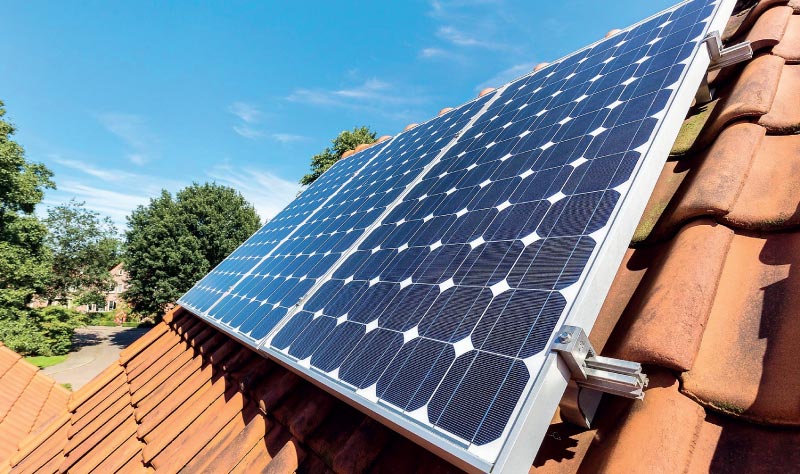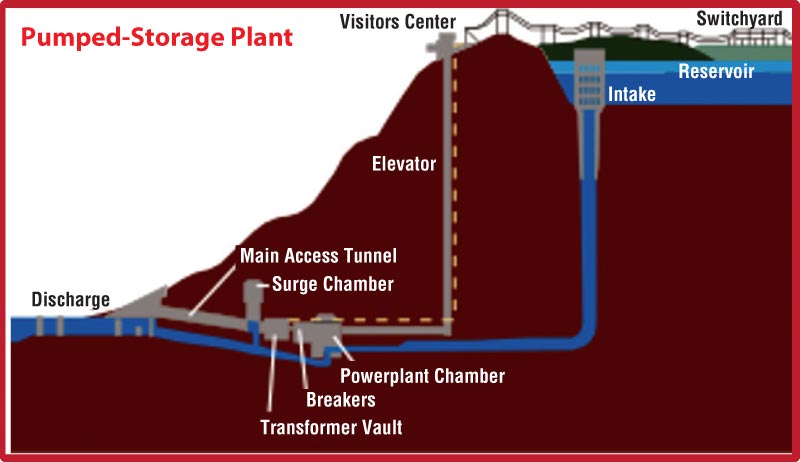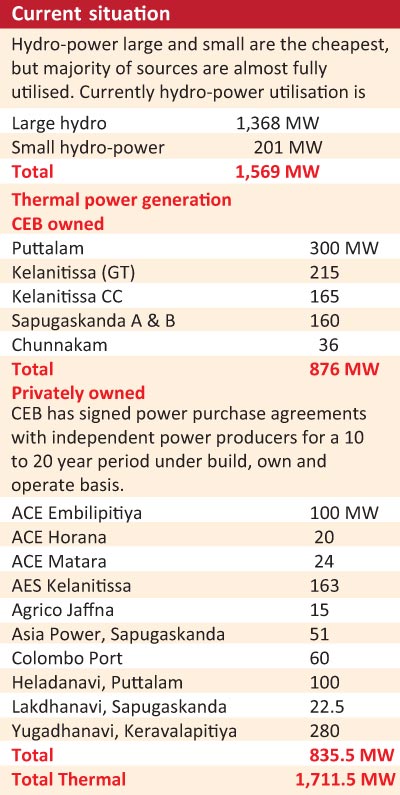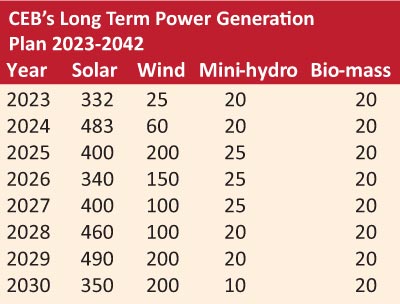Monday Apr 07, 2025
Monday Apr 07, 2025
Monday, 30 December 2024 00:00 - - {{hitsCtrl.values.hits}}

The Government needs to submit a plan to encourage installation of solar power by individual homes and the industry, with reduced interest loans from commercial banks

|
 The country’s citizens are lucky, with uninterrupted electrical power supply met from large and small hydro power plants, thermal power stations owned by Ceylon Electricity Board (CEB) and private, also to a lesser degree with bio-energy, solar and wind power. The situation could be improved with moving over to more solar and wind power.
The country’s citizens are lucky, with uninterrupted electrical power supply met from large and small hydro power plants, thermal power stations owned by Ceylon Electricity Board (CEB) and private, also to a lesser degree with bio-energy, solar and wind power. The situation could be improved with moving over to more solar and wind power.
Renewable energy
Electricity generated from hydro-power, wind, solar and bio-energy are referred to as renewable energy. The country’s hydro power sources are almost exhausted. Wind and solar power have enormous potential, initial investments are slightly higher then thermal, but running costs are low, without imports.
Solar is only during the day with intensity reducing with clouds, wind throughout the day and night, but wavering over the time and months. The country’s highest electricity demand is from 6:30 to 9 p.m. Thus solar could only contribute towards meeting the day time demand with hydro contributing throughout. Today, balance is met with thermally generated power.
Recently pumped water storage is proposed, using excessive solar power during the day time to pump water to higher levels and using the same to generate electricity during the peak hours (more later).
 Bio energy
Bio energy
Biomass projects generate power by burning tree branch cuttings or paddy husk under controlled conditions. Branch cuttings of plants (mostly grilicedia) are collected from rural farmers and paddy husk produced during milling of paddy, that are normally disposed by burning. Gliricedia plant roots known for its nitrogen fixing abilities and improve soil fertility, whose leaves are generally used as animal feed, rots easily is an excellent manure. Most dendro-power plants located in the dry rural sector, provide employment and income opportunities to growers and transporters.
Wind and solar power
Wind and solar power are highly acclaimed throughout the world, with energy produced causing least pollution and free, neither available uniformly nor throughout the day. Solar power is popular in Arab countries with massive investments. Technologies and equipment for solar and wind are imported from developed countries and are expensive, but with low running costs.
Currently, Hambantota wind farm owned by CEB has a production capacity of 3 MW and the Puttalam farm with a capacity of 10 MW. A wind farm consisting of 30 towers generating 100 MW (Phase 1 – Thambapawani) was established on the southern coast of Mannar Island in 2021, with financial assistance from the Asian Development Bank (ADB).
The Buruthakanda Solar Park in Hambantota by Sri Lanka Sustainable Energy Authority (SLSEA), first commercial scale solar power station completed in 2012, producing 737 KW in the first stage and 500 KW in the second stage.
First floating solar park
The Ambassador of the Republic of Korea, officially handed over Sri Lanka’s first-ever floating solar photovoltaic power plant located at Chandrika Wewa and Kiriibban Wewa reservoirs. The $ 5 million project, with floating solar photovoltaic power plant capable of generating 1MW, uses the reservoir surface, conserving land resources while reducing environmental impact.
Wind power potential
A World Bank report of August 2007 identified nearly 5,000 sq. km with good-to-excellent wind resource potential of 24,000 MW. About 4,100 sq. km of land and 700 sq. km in lagoons, largely concentrated in the north western coast from Kalpitiya Peninsula north to Mannar Island, Jaffna Peninsula, also central highlands.
Wind passing over Strait of Mannar
A strong stream of wind passes through the Strait of Mannar. The high speed winds moving from south to north and vice versa between central mountains of Sri Lanka and South Indian mountains through Strait of Mannar, allows generation of electricity power.
Using the same, State of Tamil Nadu has installed six wind power projects, with a capacity of 7,450 MW becoming the leader in India. The largest is the Muppandal Wind Farm with a capacity of 1,500 MW, making it the world’s forth largest onshore wind farm.
CEB installed a 103 MW wind power plant in Mannar Island with ADB assistance, costing $ 135 million and commissioned on 18 May 2021, named “Thambapavani”. The plant with 30 wind turbine generators located along the southern coast of Mannar Island. The produced electricity generated by the wind plant cost less than 4 US Cents a kWHr.
Opposition by environmentalists
But the proposed project located on the narrow ‘movement corridor’ where millions of migratory birds moving from north to south and back are severely objected by the environmentalists.
CEB Long Term Generation Expansion Plan 2023-2042
CEB’s Long Term Generation Expansion Plans (LTGEP) prepared for 2023-2042 proposes:
In addition, the plan allows pumped storage of 300 MW each for years 2029 and 2030, also are 1,400 MW Pumped Hydro Storage development by 2032 and 3,365 MW Battery Energy Storage development by 2042, requiring an average annual investment of $ 1.4 billion for generation and storage capacity additions.
 Current situation
Current situation
As per CEB generation statistics on 21 November, the combined output from the Laxapana, Mahaweli, and Samanala hydro complexes, along with CEB and Small Power Producer (SPP), wind energy and SPP solar, biomass, and mini-hydro sources, amounted to 27.22 GWh. Considering total energy generated was 47.47 Gwh, renewable energy amounts approximately to 57.35% of total energy generation. Thus achieving 70% target by 2030, Sri Lanka needs to increase its RE contribution by 27% within the next five years.
CEB’s reluctance to connect small renewable plants
Up to now, CEB showed reluctance to connect small and medium renewable plants, claiming the connection will destabilise their distribution system. But, recently, ADB agreed to provide a loan of $ 200 million to Sri Lanka to upgrade the power sector infrastructure, enhancing the reliability of transmission and distribution facilities of renewable energy, which will enable CEB to connect the renewable systems.
Mannar Wind Energy Phase II – Adani proposal
The Phase II of the Mannar Wind Energy Park of capacity 200 MW, similar to Phase I with a 5 km 132 kV transmission line. The proposed turbines located 2 km away from the existing wind turbines and production costs would be similar.
In 2022, the billionaire Indian businessman Gautham Adani visited Sri Lanka and met the President Gotabaya Rajapaksa and visited the proposed wind power project site. Subsequently, the Ministry of Power and Energy, received an unsolicited proposal for the construction and operation of the Mannar Wind Power Project (Phase-II), as Build, Own and Operate project for a 25-year period with an investment of $ 500 million.
But with a lawsuit filed in New York court, by the Securities and Exchange Commission, Adani family are facing serious allegations of bribing personnel in implementing projects. Thus offering a project to Adani family would no longer feasible.
Solar power – capabilities
Sri Lanka being close to the equator, receives an abundant supply of solar radiation year around without a marked seasonal variation. Roof-top solar is possible throughout the country except in higher elevations. Solar-parks are possible in the western coastal belt from Kalpitiya to Jaffna, Northern Province, also Hambantota and Monaragala districts due to flat dry terrain and low rain. In addition, parts of lagoons, lakes and reservoirs could host solar-parks. Thus the country’s solar and wind production capacity is beyond imagination, only needs implementation.
Rooftop solar
SLSEA introduced rooftop solar power units in 2010 which became a success, and led to Surya Bala Sangramaya or the battle for solar energy in 2016. New program targets adding 1,450 MW by 2025. Currently 20,000 solar systems supply 215 MW to national grid, dominated by small roof-top solar installations. Thus rooftop solar needs to be promoted vehemently.
Under the current system, rooftop solar producers up to 500 KWs are paid a Rs. 37 flat rate for 20 years, while systems above 50 KWs are paid Rs. 34.50 per unit.
Norochcholai Coal Power Plant
Sri Lanka’s first and the largest power station implemented as a joint venture by CEB with aid from EXIM Bank of China. It was constructed by China Machinery Engineering Corporation at a cost of $ 1.35 billion. The contract was signed in 2006 and the first phase of 300 MW was commissioned in 2011, including the construction of 115 km transmission line connecting the plant to the national grid through the Veyangoda substation.
The Norochcholai Coal Power Plant located in Puttalam District, on the West Coast of the Kalpitiya Peninsula. The power plant proposed as 3 phases, each phase adding 300 MW, making the total power generated as 900 MW. A 300 MW unit of the Norochcholai plant would use between 650,000 to 700,000 tonnes of coal a year.
Small and medium industries and supermarkets
There are large number of small and medium scale industries, who are occupied during daytime (when the sun is shining) with large roofs. Also are large number of supermarkets, all with large roofs. These roofs could be utilised effectively by installing solar power systems. Solar panels on the roof will reduce the sun-light on the roof, reducing the air-conditioning load below. Some Supermarkets already have solar panels on their roofs, others too could follow and owners cannot claim to be short of funds.
Personal achievement
I have installed a 14 kW solar system on my roof-top, costing Rs. 2.1 million, the system consisting of 34 solar panels. I have paid all requirements to CEB and am awaiting them to connect the solar power system.
Power from wind turbines
Now that Adani’s wind power proposal is no longer acceptable, the Governments need to call for expression of interest world-wide for future installation wind power systems in Mannar, Jaffna regions as well as up on the hills. In the hilly areas, most grounds are Government owned and there would be no objection for the locals.
Pumped storage plants
A pumped storage hydro-electric plant generally consists of two water reservoirs at different levels, connected with each other. During low electricity demand, excess generation capacity (excessive solar power) is used to pump water into the upper reservoir. With the high demand in peak hours, water is released back into the lower reservoir through a turbine (usually a Francis turbine), generating electricity.
Pumped storage plants, usually use reversible turbine/generator assemblies, acting both pump and as a turbine generator at variable speed operation, further optimising the efficiency in pumped hydro storage tanks. For pumping of water, also for power generation, the same pump is used by changing rotational direction and speed.
Wewathenna Pumped Storage Plant
Pumped storage power plants (PSPPs) have been identified as a viable solution for power generation for Sri Lanka. Wewatenna was identified in the Electricity Sector Master Plan Study of Sri Lanka conducted in 2018 as a suitable site. This study develops the basic design configuration and calculates the peaking energy of the proposed PSPP at Wewathenna using the methodologies employed in previous studies conducted in 2015.
The proposed Wewathenna project uses existing Victoria reservoir as the lower pond. The catchment area of the existing “Victoria” is 6.64 km2 and to construct an artificial dam on the eastern side of Victoria Lake serving as the upper pond of capacity 0.33 km2. The net head and maximum discharge are planned as 686 m and 240 m3/s respectively, with a potential capacity of 1,400 MW. However, due to various restrictions, Wewatenna was based on 500 MW. But adhering to manufacturing limit of pump-turbines, the unit capacity was set at 350 MW.
Revised tariffs from CEB
The regulator PUCSL requested CEB a revised plan for tariff reduction starting 1 January 2025, and set a deadline for submission by 6 December 2024. But CEB refused any reductions of rates, claiming excess water in reservoir need to be saved to cater till April, end of dry period. Failure will require power generation through oil and coal.
Former PUCSL Chairman Janaka Ratnayake added that the generation cost of electricity has decreased from Rs. 50 to Rs. 28, and electricity tariffs should be reduced by at least 30% passing relief to the public. The consumers have noted that recent heavy rains have significantly boosted hydropower generation and would allow reduction of electricity charges.
Meanwhile, CEB unions called for bonuses, highlighting that the CEB recorded a profit of Rs. 43 billion in 2023 and Rs. 161 billion in 2024. But CEB rejected the demand for bonus. Also no reduction in electricity prices during the next six months, due to lack of low cost energy sources.
Importance of solar power
The country has almost exhausted its cheapest power hydro-electricity. Only possibility is major movement towards solar power, especially by small and medium scale industries and house owners. Most convenient new solar users would be factories and offices, who normally work during day-light hours. Also, most schools have fans in the classrooms. They could install solar panels on the roofs, eliminating electricity bills. The parents who installed the fans in classrooms could also install solar panels.
Meanwhile, it was reported that Orion City, the nation’s premier IT and business park has invested in a 700 kW solar power at its Colombo 9 complex, ensuring 24/7 uninterrupted power supply to its customers, would be an example to others.
Thus, the Government needs to submit a plan to encourage installation of solar power by individual homes and the industry, with reduced interest loans from commercial banks. Recently, delegates from Japan and Qatar met the President and have offered assistance for renewable energy. Also, a number of European countries have offered low interest loans for renewable power. If the Government takes initiative to get their assistance, new solar investors could be offered low interest loans, will be a great support to the new investors, and will improve the solar power industry and the country.